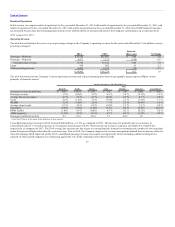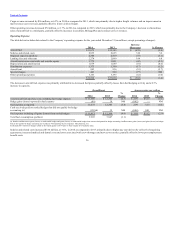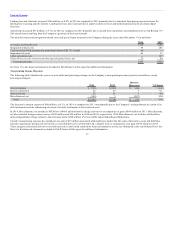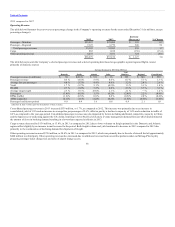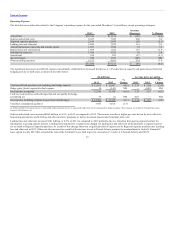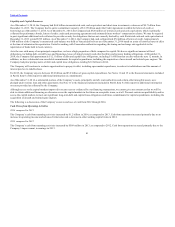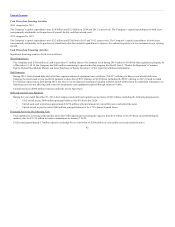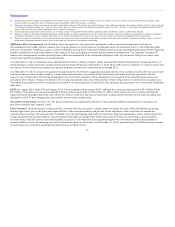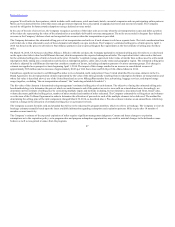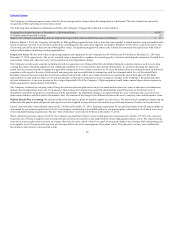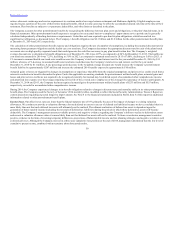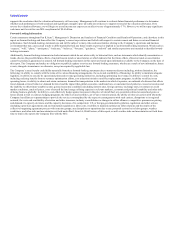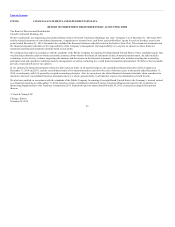United Airlines 2014 Annual Report Download - page 45
Download and view the complete annual report
Please find page 45 of the 2014 United Airlines annual report below. You can navigate through the pages in the report by either clicking on the pages listed below, or by using the keyword search tool below to find specific information within the annual report.
Table of Contents
(b) Includes interest portion of capital lease obligations of $58 million in 2015, $52 million in 2016, $32 million in 2017, $23 million in 2018, $18 million in 2019 and $210 million thereafter. Future
interest payments on variable rate debt are estimated using estimated future variable rates based on a yield curve.
(c) Represents our estimates of future minimum noncancelable commitments under our CPAs and does not include the portion of the underlying obligations for aircraft and facility rent that is disclosed as part
of aircraft and nonaircraft operating leases. Amounts also exclude a portion of United’s capital lease obligation recorded for certain of its CPAs. See Note 13 to the financial statements included in Part II,
Item 8 of this report for the significant assumptions used to estimate the payments.
(d) Amounts represent postretirement benefit payments, net of subsidy receipts, through 2024. Benefit payments approximate plan contributions as plans are substantially unfunded.
(e) Represents estimate of the minimum funding requirements as determined by government regulations for United’s material pension plans. Amounts are subject to change based on numerous assumptions,
including the performance of assets in the plan and bond rates. See Critical Accounting Policies, below, for a discussion of our current year assumptions regarding United’s pension plans.
(f) Represents contractual commitments for firm order aircraft and spare engines only and noncancelable commitments to purchase goods and services, primarily information technology support. See Note 15
to the financial statements included in Part II, Item 8 of this report for a discussion of our purchase commitments.
Off-Balance Sheet Arrangements. An off-balance sheet arrangement is any transaction, agreement or other contractual arrangement involving an
unconsolidated entity under which a company has (1) made guarantees, (2) a retained or a contingent interest in transferred assets, (3) an obligation under
derivative instruments classified as equity, or (4) any obligation arising out of a material variable interest in an unconsolidated entity that provides financing,
liquidity, market risk or credit risk support, or that engages in leasing, hedging or research and development arrangements. The Company’s primary off-
balance sheet arrangements include operating leases, which are summarized in the contractual obligations table in above, and
certain municipal bond obligations, as discussed below.
As of December 31, 2014, United had cash collateralized $74 million of letters of credit. United also had $410 million of performance bonds and letters of
credit relating to various real estate, customs and aircraft financing obligations at December 31, 2014. Most of the letters of credit have evergreen clauses and
are expected to be renewed on an annual basis and the performance bonds have expiration dates through 2019.
As of December 31, 2014, United is the guarantor of approximately $1.8 billion in aggregate principal amount of tax-exempt special facilities revenue bonds
and interest thereon. These bonds, issued by various airport municipalities, are payable solely from rentals paid under long-term agreements with the
respective governing bodies. The leasing arrangements associated with a majority of these obligations are accounted for as operating leases and are not
recorded in the Company’s financial statements. The leasing arrangements associated with a portion of these obligations are accounted for as capital leases.
The annual lease payments for those obligations accounted for as operating leases are included in the operating lease payments in the contractual obligations
table above.
EETCs. In August 2014, April 2014 and August 2013, United completed three separate EETC offerings for a total principal amount of $2.9 billion. Of the
$2.9 billion, United has received and recorded $2.0 billion of proceeds as debt as of December 31, 2014. United expects to receive all proceeds from the
August 2014 pass-through trusts by the end of 2015. See Notes 11 and 14 to the financial statements included in Part II, Item 8 of this report for additional
information on EETC pass-through trusts and variable interest entity consideration.
Increased Cost Provisions. See Note 15 to the financial statements included in Part II, Item 8 of this report for additional information on increased cost
provisions related to the Company’s debt.
Fuel Consortia. United participates in numerous fuel consortia with other air carriers at major airports to reduce the costs of fuel distribution and storage.
Interline agreements govern the rights and responsibilities of the consortia members and provide for the allocation of the overall costs to operate the
consortia based on usage. The consortia (and in limited cases, the participating carriers) have entered into long-term agreements to lease certain airport fuel
storage and distribution facilities that are typically financed through tax-exempt bonds (either special facilities lease revenue bonds or general airport
revenue bonds), issued by various local municipalities. In general, each consortium lease agreement requires the consortium to make lease payments in
amounts sufficient to pay the maturing principal and interest payments on the bonds. As of December 31, 2014, approximately $1.4 billion principal amount
of such bonds were secured by significant fuel facility leases in which United
45


